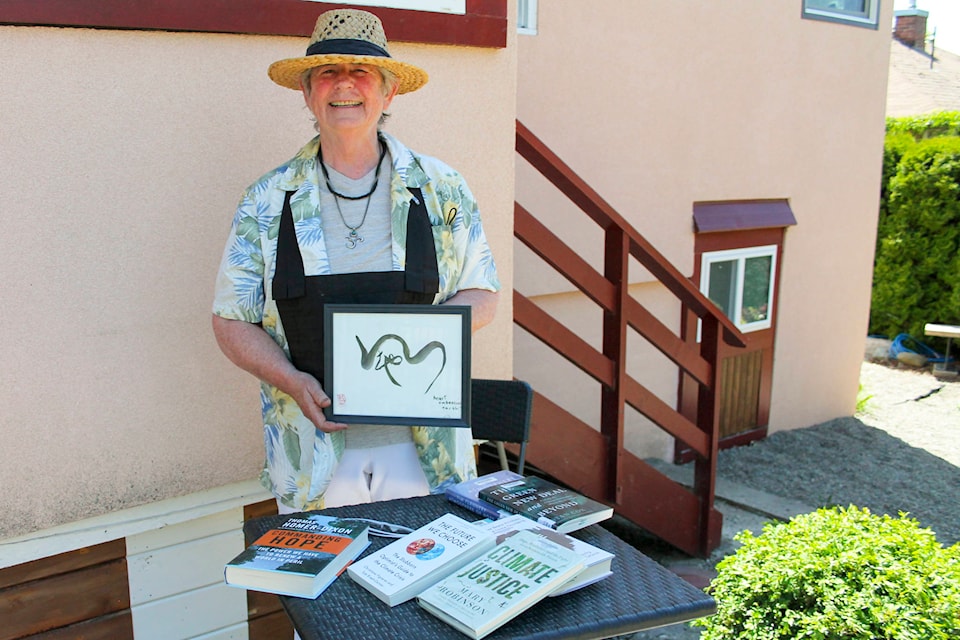By Kuya Minogue, resident teacher at Sakura-ji
How can we meet and reverse this rolling ball of heat? An entire lake in Antarctica has just drained into the ocean, methane is leaking from the melting tundra in the Russian Arctic, and our hills and lungs are filling with smoke.
And it’s hot, damned hot. This June, one of the many statistically projected climate heat disaster scenarios landed in Creston, and according to climate scientist, Kritee Kanko, the heatwave is happening 10 years ahead of scenario projections. It was 47 degrees on my front porch, raspberries cooked on their stalks, and my pea flowers melted on the vine. Is my food supply threatened? It would seem so. And our federal and provincial governments are still subsidizing and supporting fossil fuel industries, and the BC government still upholds the logging of B.C.’s old growth and boreal forests. I won’t waste your time with evidence; you can Google it.
When I place the severity of our situation on a 1 to 10 scale, 10 being the most severe, I put the threat firmly at a 10. When I place the proportionality of Canada’s and B.C.’s response, 10 being perfectly proportionate to the multiple threats of climate change, I’d put it sadly at a 2. There’s something wrong with this picture! How would you rate these matters?
The failure of the province’s Emergency Services systems in Vancouver to meet the demands of the heat tells the story. Because the response did not, and could not match the threat, people died. This gap between threat and response is part of the reason I feel that our governments need to wake up and make some tough decisions. The earth’s metabolic system is on a runaway. If, as Shantideva says, “there is no help for it,” the techno-optimists cannot save us. But maybe if all mitigation and adaptation efforts were combined with an international greening movement, our situation could improve.
Shantideva, an 8th Century Buddhist monk said:
“If there is a remedy when troubles strike, what reason is there for despondency? And if there is no help for it, what use is there in being sad.”
This reminds me of that 1988 hit song by Bobby McFerrin - “Don’t worry; be happy.” But there is a subtle difference in how I hear the message now. In the 1980s the Berlin Wall came down, Chernobyl happened, and a bomb brought down passenger flight 103 over Scotland. “Don’t worry; be happy.” I took Bobby’s advice, but at the time I confused happiness with burying awareness of the threats in the distractions of mindless entertainment. Since then, I have come to understand that, as the Dalai Lama says almost every time he speaks, “The only path to true happiness is to work for the happiness of others.”
This is how I see the practice of Active Hope.
Shantideva said there is no use in being sad. I disagree with this. For me, there is use in being sad, or as Joanna Macy has named it, “In feeling our pain for the world.” To do so is a crucial practice, if we aspire to change our collective mindset from denial and distraction to positive action. Ironically, fully facing our pain can help us keep a bright mind, and use it to fuel practices of intelligent active hope. Any therapist will tell you that this is also true at a personal level.
Suggested Practice:
If your concerns for the future get overwhelming, it helps to “breathe through” your worried thoughts, distressed emotions, and disturbing mental images. Take some time each day to breathe these disturbing mind/body events into awareness and then, on the out breath, breathe them out again. Let them go through you on your breath. This practice calms me down so I can turn my attention to what is before me: imagining a better world, asking myself what my part is in helping create that better world, and then taking the next act of hope. Soon, we will all be taking to the streets to protest government inaction on issues vital to the health of our community. Watch for it.
